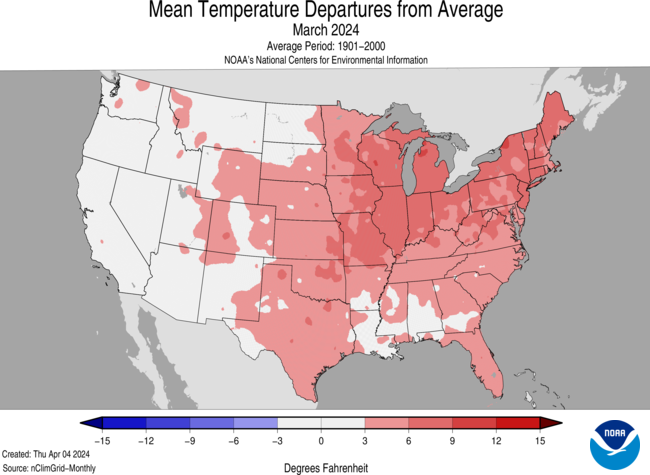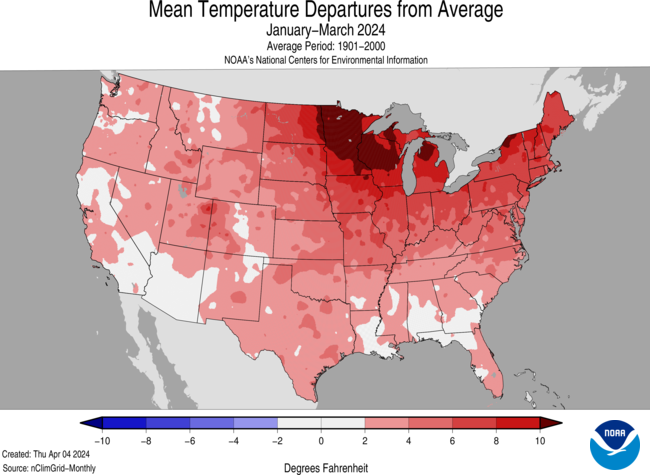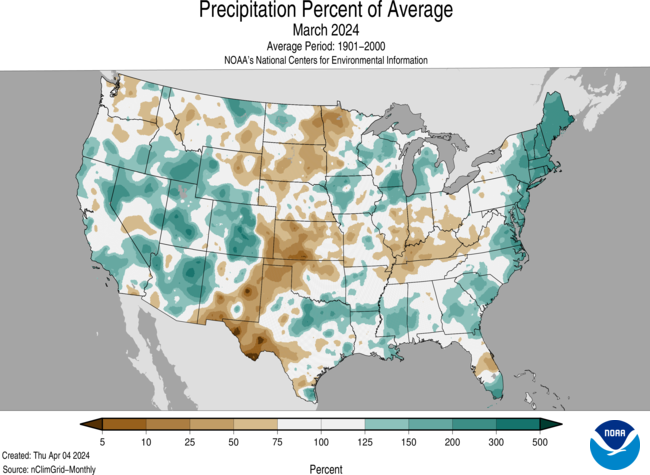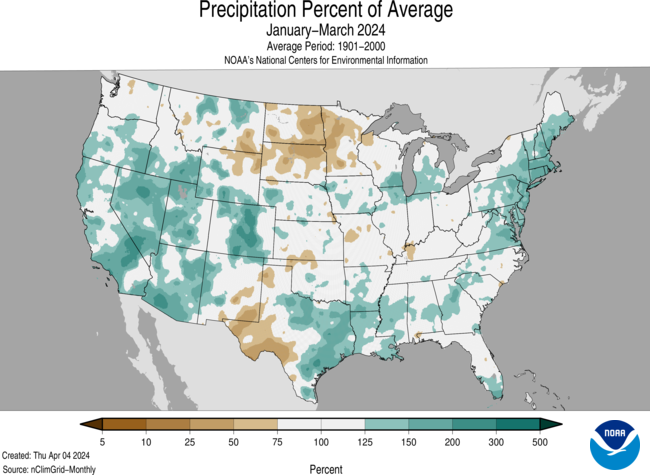Severe storms brought large hail and tornadoes to portions of the Midwest; blizzard buried parts of California under feet of snow

Key Points:
- March 12–15 saw the most intense severe weather outbreak of the year through March 31 after powerful storms brought baseball-sized hail and more than 20 tornadoes to portions of the Midwest, resulting in significant damage and loss of life.
- A blizzard blasted parts of California’s Sierra Nevada with gusts of up to 190 mph and more than 10 feet of snow at the beginning of March.
- March 2024 was the 17th-warmest March on record for the nation and precipitation ranked in the wettest third of the historical record for the month.
Other Highlights:
Temperature

The average temperature of the contiguous U.S. in March was 45.1°F, 3.6°F above average, ranking 17th warmest in the 130-year record. March temperatures were above average across much of the contiguous U.S., while below-average temperatures were observed in small pockets of the West and Southwest.
The Alaska statewide March temperature was 14.1°F, 3.3°F above the long-term average, ranking in the warmest third of the 100-year period of record for the state. Above-average temperatures were observed across much of the state with near-normal temperatures in parts of the North Slope, Interior, Southwest and parts of the Aleutians and Panhandle.

For January–March, the average contiguous U.S. temperature was 39.4°F, 4.2°F above average, ranking fifth warmest on record for this period. Temperatures were above average across most of the contiguous U.S., while record-warm temperatures were observed in parts of the Northeast. Wisconsin, Michigan, New York, Vermont, New Hampshire and Maine each ranked second warmest for the January–March period.
The Alaska January–March temperature was 9.4°F, 3.5°F above the long-term average, ranking in the warmest third of the historical record for the state. Much of the state was above normal for the three-month period while temperatures were near average across the eastern portions of the state and in parts of the Aleutians and Panhandle.
Precipitation

March precipitation for the contiguous U.S. was 2.85 inches, 0.34 inch above average, ranking in the wettest third of the historical record. Precipitation was above average across much of the West, in the Great Lakes and along the Gulf and East coasts and in parts of the northern Plains. Conversely, precipitation was below normal across much of the Ohio Valley, the Plains, and in parts of the Northwest and Florida. Maine and Rhode Island each had their second-wettest March on record.
Alaska’s average monthly precipitation ranked in the middle third of the historical record. Precipitation was above average in parts of the North Slope, West Coast and Southeast, while below-normal precipitation was observed in parts of the central Interior, south-central Alaska and in parts of the Panhandle during the month.

The January–March precipitation total for the contiguous U.S. was 8.15 inches, 1.19 inches above average, ranking 10th wettest in the 130-year record. Precipitation was above average across much of the contiguous U.S., with Rhode Island having its second-wettest year-to-date period on record. Conversely, precipitation was below average across much of the northern Plains and in small parts of the Northwest, central and southern Plains, Ohio Valley and Southeast during the January–March period.
The January–March precipitation for Alaska ranked in the wettest third of the 100-year record, with above-average precipitation observed in parts of the North Slope, West Coast and Southeast, while below-normal precipitation was observed in parts of the central Interior and south-central Alaska, as well as southern portions of the Panhandle during this period.
Billion-Dollar Disasters
One new billion-dollar weather and climate disaster was confirmed in March 2024 after a severe weather event impacted the central and southern U.S. during mid-March, with the most severe weather occurring on March 13–15.
The U.S. has sustained 378 separate weather and climate disasters since 1980 where overall damages/costs reached or exceeded $1 billion (including CPI adjustment to 2024). The total cost of these 378 events exceeds $2.675 trillion.
Other Notable Events
Five wildfires, including the Smokehouse Creek wildfire, were finally contained in the Texas Panhandle, the largest cattle-producing region in the world. The wildfires resulted in approximately 1.1 million acres scorched, hundreds of destroyed structures, hundreds of miles of ruined fencing and more than 7,000 dead cattle.
Winter did not bring heavy snowfall to Wisconsin nor the temperatures necessary to maintain the snow, allowing fires to begin early and in high numbers. Between January–March 2024, there have been more than 220 fires across Wisconsin.
A 5.25-inch diameter hail stone fell in Ada, Oklahoma on March 14, which is the largest stone reported in Pontotoc County since 1950, as well as the largest to fall in the state in nearly 13 years.
A state of emergency was declared for Ohio as several tornadoes struck the state, resulting in 3 fatalities on March 14 when an EF-3 tornado crossed Auglaize and Logan Counties.
Drought
According to the April 2 U.S. Drought Monitor report, about 18% of the contiguous U.S. was in drought, down about 3.6% from the end of February. Drought conditions expanded or intensified in portions of the Plains and in parts of the Northwest, central Mississippi Valley, northern Great Lakes and Hawaii this month. Drought contracted or was reduced in intensity across much of the Mississippi Valley, Puerto Rico and the West, and in parts of the Plains, Great Lakes and Carolinas.
Monthly Outlook
Above-average temperatures are favored to impact much of the central U.S., Northwest and Northeast in April while above-average precipitation is likely from much of the Plains to parts of the East Coast and in much of the Southwest. Drought is likely to persist along portions of the Northern Tier, the Southwest, Hawaii and Puerto Rico. Visit the Climate Prediction Center’s Official 30-Day Forecasts and U.S. Monthly Drought Outlook website for more details.
Significant wildland fire potential for April is above normal across much of the Upper Midwest and in parts of the central and southern Plains. For additional information on wildland fire potential, visit the National Interagency Fire Center’s One-Month Wildland Fire Outlook.
This monthly summary from NOAA’s National Centers for Environmental Information is part of the suite of climate services NOAA provides to government, business, academia and the public to support informed decision-making. For more detailed climate information, check out our comprehensive March 2024 U.S. Climate Report scheduled for release on April 11, 2024. For additional information on the statistics provided here, visit the Climate at a Glance and National Maps webpages.



